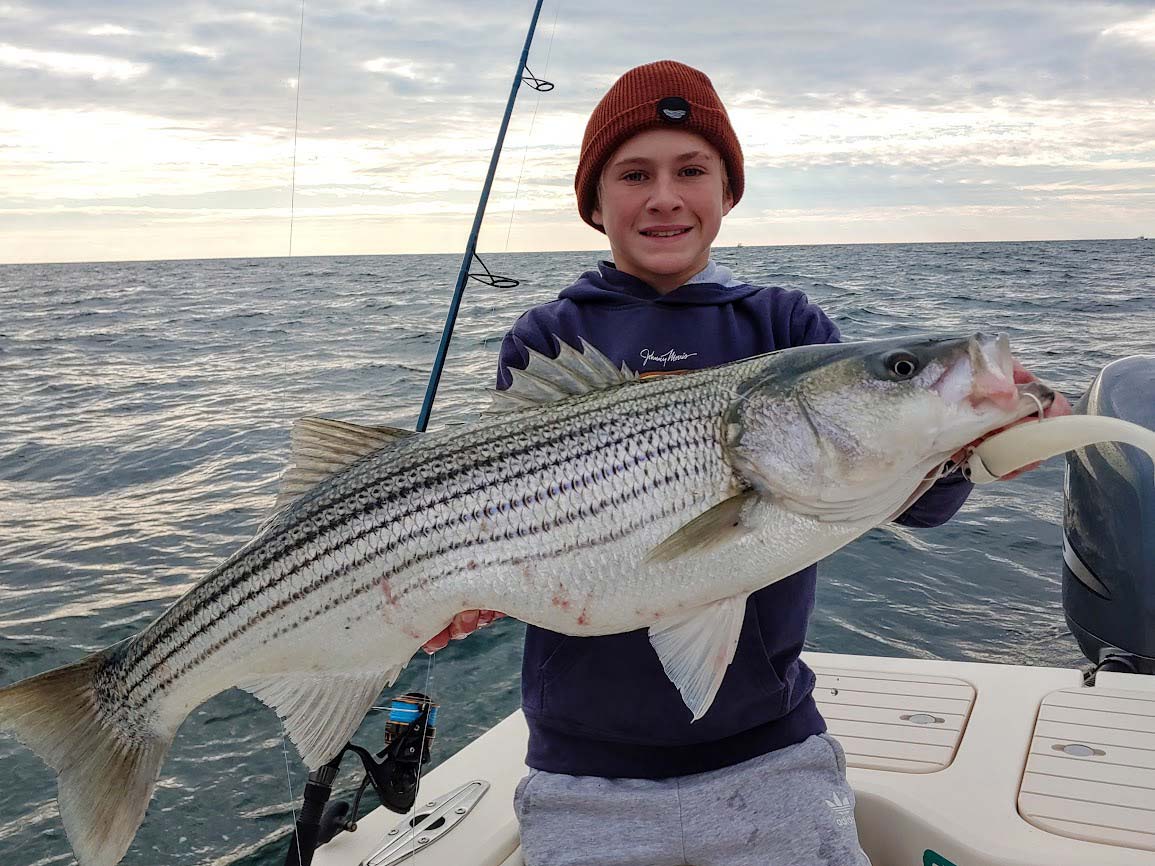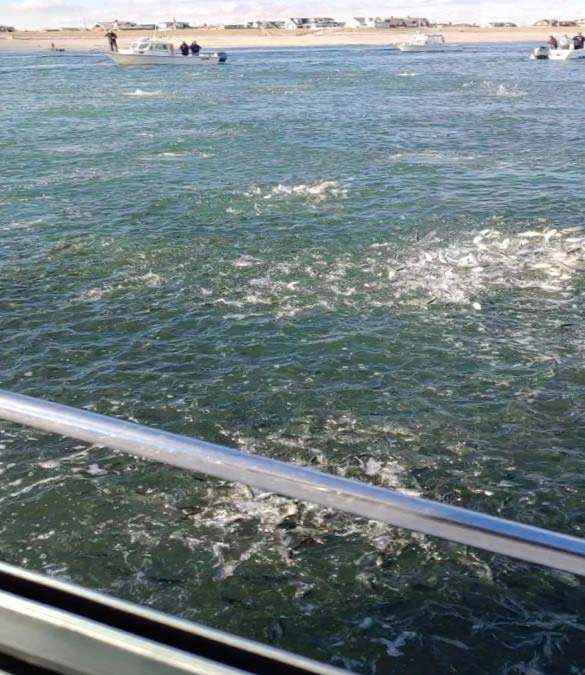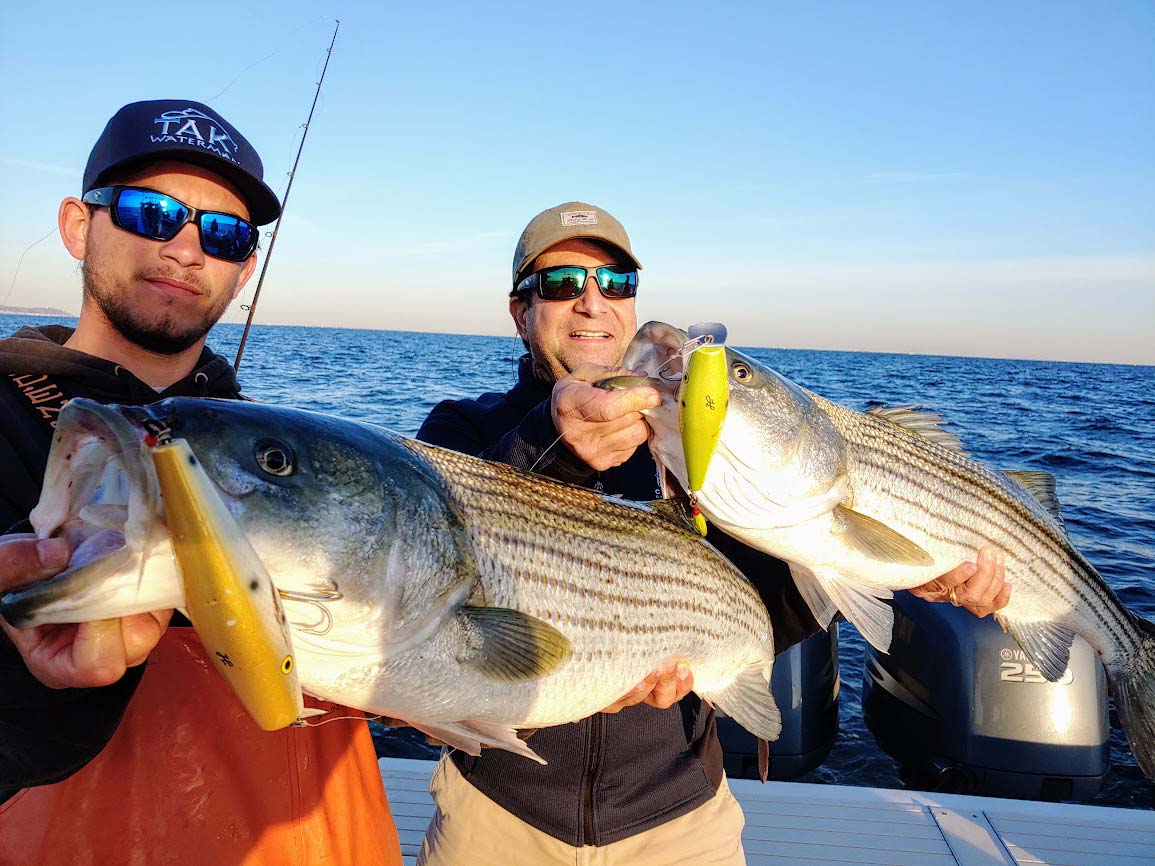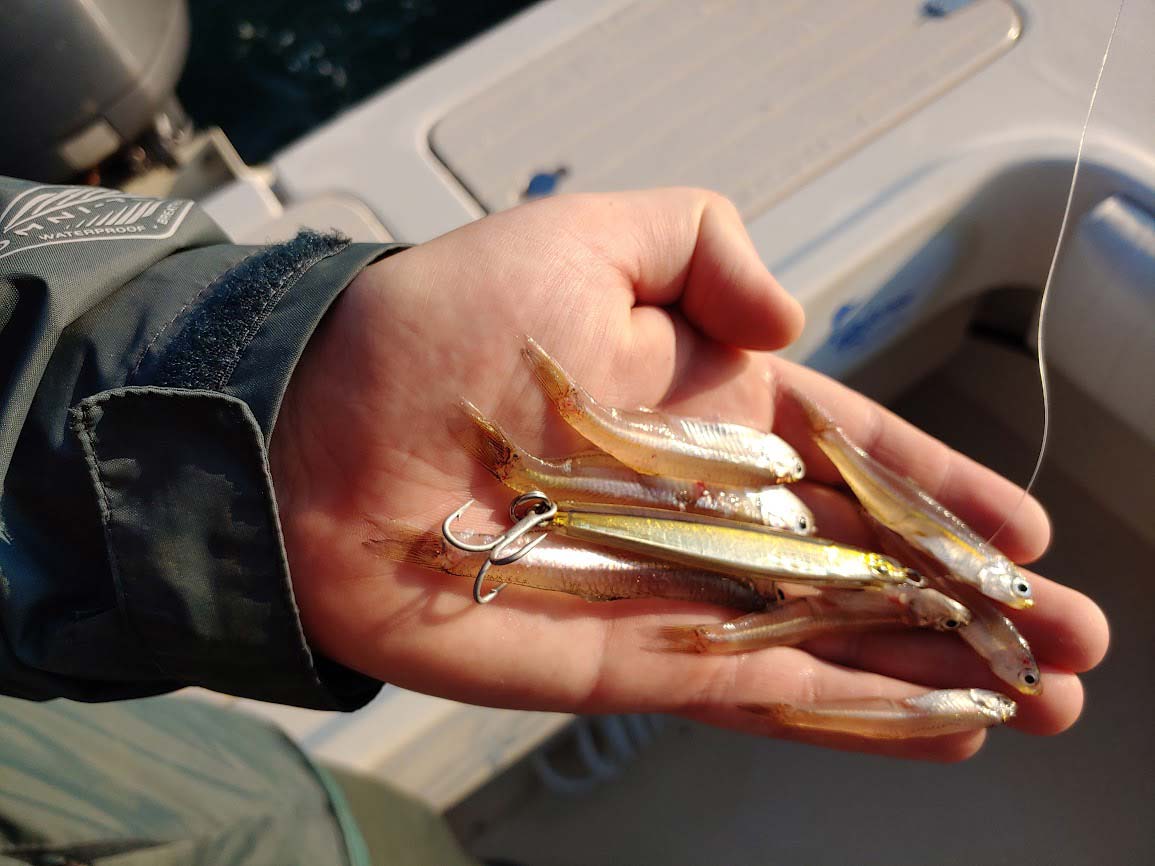
With October’s arrival, so too comes the first waves of migratory striped bass at the Jersey Shore!
There will be many days when catching bass will be a no-brainer as blitzes will erupt right at your feet or under your gunnels. Many days will now end with weary arms and great satisfaction.
But not every day is magical, so it is best to be prepared with a knowledge and understanding into the nature and behavior of the prevalent baits that drive our blitzes through December. When you understand and know your baits you can best select the artificial that most closely resembles the natural.
October Baits
As we enter October there should be a remnant of mullet that remains; while predominantly a September bait, mullet will migrate south particularly on the downside of the full and new moons of the month. Our local mullet (mugil cephalus), also known as the striped mullet, can easily be spotted in the surf zone as they will sketch a perfect trace of our coastline while migrating north to south along the beach. When the surf is calm, they will swim near the surface in the upper third of the water column making a characteristic wake as they move along. For this reason, I like to use poppers as my go to lure as bass will come up and attack and them from below.
Surface poppers such as the small Madd Mantis, Spro Popper50, Stillwater Smack-Its, Polaris, or Creek Chub poppers will all work well. You can also fish 4- to 6-inch shallow swimming plugs such as Bombers, Yo-Zuri, and Megabaits. Soft shads such as the DuraShad and Flex Lure by Spro, Tsunami swim shads or Storm Wildeyes will also work. Best colors for all these artificials will be pearl, silver, blue, or green over white or all white. But don’t rule out all yellow either.
For mullet fly imitations try Popovics’ siliclones, bucktail deceivers, bangers, and Popovics’ modified siliclone known as the “Pop Lips”. Other flies to carry are deer hair sliders, snake flies, bulky deceivers, and sar-mul-macks. Fly sizes should range from 4 to 6 inches for finger mullet.

The greatest concentration of baits during October however will most likely be bay anchovies and spearing that will trigger blitzes both along the beach and in the boat. Bay anchovies are commonly referred to as rainfish as they will dimple the surface of the water like raindrops falling on it. They will be 1 to 3 inches long. Spearing on the other hand can be present in different sizes ranging from 3 to 6 inches long.
Both anchovies and spearing have a similar profile with a prominent iridescent stripe running along the lateral aspect of their body. Therefore, the same kinds of artificials can be used to imitate them. When casting artificials I like to throw any small thin profile metal. Deadly Dicks are my number one choice. But small Avas, thin Hopkins, or tin squids, or any of the new epoxy jigs from Tsunami or Hogy are also good choices. It is also very effective to fish a small teaser 18 to 24 inches above these artificials. Many times, double headers will result. When jigging from your boat in these schools of bait all the above artificials will work along with Ava 27’s or 47’s without tails.
When fishing flies, artificials tied sparsely are often very effective as they nicely embody the translucency of these smaller baits. Therefore, use 1- to 4-inch Popovics surf candies, deep candies, simple-clones, or jiggies. Also try Skok’s white bait mushy, Farrar’s softex patterns, clousers, and bunny flies.
November’s Great
As November approaches dropping ocean temperatures from 59 to 50 degrees will stimulate striped bass to feed voraciously and gorge themselves as they prepare to exit out of our area towards southern waters. Peanut bunker will now take center stage along our New Jersey beaches. Peanut bunker are the first year young of the adult mossbunker commonly known as menhaden. They are silvery in appearance on their dorsal surface but will have different hues of green, blue, and purple mixed in as well. Their underbellies are pearl to white and they have a single black spot under the pectoral fin. Their profile has length and height but lacks width. By November their length is 3 to 6 inches long.
Livelining a peanut is one of the most successful methods to connect with a striped bass. To obtain baits you can either cast net them when fishing from your boat or snag them when fishing the surf. It’s important to remember that snagging and dropping live baits for striped bass is now a thing of the past and circle hooks can only be used. Using a 2/0 Gamakatsu circle hook place it just above the dorsal. Flip cast the bait into the pod and let it go. Get ready for a quick take as the bass will inhale the bait in one swipe.

A wide selection of artificials will also work well when the bass are not finicky and zeroed in on the real thing, including 4- to 6-inch swimming plugs, Rat-L-Traps, poppers, and soft plastics. For all these artificials white or pearl is the preferred color to use. Also, fish these with a pause to emulate a stunned or injured bait. If you are tossing metal the shorty Hopkins, 1-ounce Kastmasters, 3/4-to 1-ounce Krocodiles, and the 2-ounce Crippled Herring are the ones to use. For best results with your metals impart a fluttering action to them on the retrieve.
If you are fly fishing select flies that have a wide profile or girth. Popovics’ hollow fleye, Geno’s Baby Angels, Lefty’s deceivers, Chinourd’s Wideside, and Farrar’s baby bunker are all good choices. Fly sizes should range from 4 to 6 inches. For fly colors white is of key importance and all your flies should have a large mix of it tied in. White underbellies are important to match the white underbelly of the bait.
December To Remember?
The two baits that we look for that will make or break the end of our season are sand eels and sea herring. If either bait appears than our season can extend well into December. These two baits move inshore when surface temperatures range between 52 to 46 degrees. The sand eel or sand launce (lance) is an inshore species not related to the common eel. Its scientific name ammodytes americanus literally means sand burrower, a typical behavioral pattern of the sand eel when it is fleeing from a predator or resting. Sand eels are recognized by their slender body with a pointed snout. They have a long dorsal and anal fin and are deep blue green to bronze on their back with a white belly. They are commonly found in the 4- to 6-inch ranges.
Sand eels may take up residence in the surf zone after moving in from deeper inshore waters. When they do you will find them rooting along a sandbar. By boat, one will have a much higher degree of success in locating sand eels as they concentrate in large numbers over sandy bottoms. When utilizing your fishfinder, sand eels will appear as tightly packed balls of bait near the bottom on your screen.
There are a multitude of soft baits, metals, plastics, and wood that can be cast to imitate sand eels by either the surfcaster or boater. Surfcasters will want to carry an assortment of artificials in their bag. Needlefish such as the Gibbs, Boone, Habs, or Superstrike are time proven favorites. Needlefish are a do nothing lure that is cast out and retrieved slowly with just a twitch of the rod tip every four or five turns of the reel handle.
For metals use small Ava’s 27-47 or 67’s with tails, Deadly Dicks, Stingo PBJ’s, A.O.K. T-Hex metals, Need-L-eels, long Hopkins, Jetty Ghost sandeel, and tin squids. All of these artificials can be fished with a teaser such as a Femlee eel, Red Gill, Vision sand eel, or fly, tied on with a dropper loop 18 to 24 inches above the artificial which can often result in double headerstriper catches.
In the soft plastic arena, the Hogy Sandeel series, Skinny Hogy, and Ron-Z are my top choices used in conjunction with 1-3 ounce weighted jigheads. The weighted Tsunami’s, Joe Baggs, Vision Surf Eel, Bill Hurley, Savage, Berkeley PowerBait sand eel can’t miss either. All the above artificials will also work from the boat. From the boat deep water jigging has traditionally been one of the most successful methods as sand eels will normally be located down deep.

When fly fishing sand eel patterns should have a long slender slim profile fly will work best. Popovics’s stick candies, keel eel, and jiggies are my number one choice. Also try Farrar’s silly skin sandeel, clousers, and half and halfs.
The sea herring, also known as the Atlantic herring (clupea harengus), are the edible baits that are normally jigged in the winter around our inlets and then pickled and canned. They are steel to greenish-blue on their dorsal surface fading to silver on the sides and belly. They have a dark, oily, full-flavored meat. Small immature herring of 1 to 2 years are called sardines. By boat, sea herring can be located by looking for groups of diving gannets or gulls. These birds usually pinpoint their location when these baits are being pushed to the surface by marauding schools of big bass. We have witnessed some amazing sights in the cool December waters as schools of 20- and 30-pound bass can be seen savagely attacking these baits right next to the gunnels of our boats.
There are many swimming plugs and stickbaits that can be bought over the counter that will work but at this time of year but I like to break out the custom wood swimmers, poppers, or pencils that I was given or bought from the custom plug makers in my area over the years. M. Fischer poppers, Cuozzo’s Pajama Plugs, Leftys, Wades, Big Dons, McFaddens, T-Bones, Bottomly’s, and Tom Brown’s JP Surfsters top my list. The heavy weighted Tsunami Shad in pearl and the 10-inch white Hogy are also deadly to use.
For flies large Popovics’ bucktail deceivers and hollow fleyes are my first choice as these flies are easy to cast and present a wide and long profile in the water. Big synthetic bunker flies or other herring patterns will also work such as Skok’s mega mushy or half and halfs.




